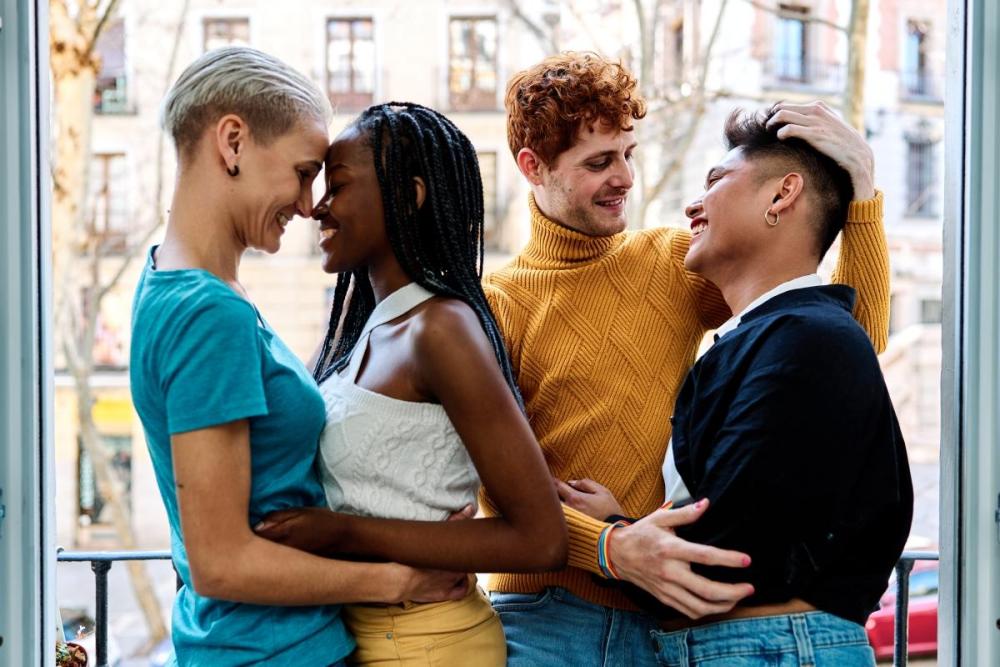Whether you’re curious about polyamory, already navigating multiple relationships, or simply exploring alternatives to traditional monogamy, this guide covers everything you need to know — from different types of polyamorous relationships to communication strategies, challenges, and benefits.
Let’s talk about love. Not just the traditional, one-and-only kind, but the expansive, evolving world of polyamory — because sometimes, one person simply isn’t enough to hold all the love we have to give.
More and more people are realizing that gender and sexuality aren’t set in stone, and relationships don’t have to be either. The idea that everyone must fit into a box labeled “monogamy” is shifting, making space for new ways to connect and commit. We’re moving past the old “either-or” mindset — male or female, gay or straight, single or taken — and embracing a more flexible, authentic approach to love. And polyamory ? It’s a big part of that shift.
So, What Exactly Is Polyamory?
Polyamory, from the Greek “poly” (many) and the Latin “amor” (love), is all about having multiple romantic or sexual relationships at the same time — with the full knowledge and consent of everyone involved. It’s not about sneaky side flings or emotional betrayal — polyamory is rooted in honesty, transparency, and ethical non-monogamy . Everyone involved is on the same page, creating a relationship structure that works for them.
Non-monogamous relationships aren’t new, but more people today are speaking openly about their experiences and redefining what love and commitment can look like.
Types of Polyamorous Relationships
Not all polyamorous relationships look the same. Here are a few common approaches:
Hierarchical Polyamory
This structure involves a primary partner who takes priority when it comes to emotional intimacy, time, and major life decisions. Other relationships (secondary and tertiary partners) may be meaningful but typically have less influence over major commitments such as living arrangements, finances, or children.
Non-Hierarchical Polyamory
In this arrangement, there is no ranking system, meaning all partners are valued equally. No single relationship is inherently more important than another, and decisions that affect the group are made collaboratively. This structure fosters a balance where each partner has autonomy, and relationships develop based on their own dynamics rather than predefined levels of priority.
Solo Polyamory
Solo polyamorists maintain multiple romantic and sexual relationships while prioritizing their independence. They typically do not seek traditional relationship markers like cohabitation, marriage, or financial merging. Instead, they value autonomy and self-sufficiency while still fostering meaningful and committed relationships. Solo polyamory is ideal for those who want connection without the societal pressures of conventional partnership structures.
Polyfidelity
This setup involves a closed, committed relationship among multiple partners where no one dates outside of the established group. Unlike open polyamory, where new partners may be introduced freely, polyfidelity operates within a predefined group. Some polyfidelitous groups may have strict agreements regarding exclusivity, while others may allow for occasional flexibility as long as all members consent.
Relationship Anarchy
Relationship anarchists reject traditional labels and hierarchical structures. Instead of following predetermined relationship scripts, they define their connections on a case-by-case basis, prioritizing autonomy, mutual respect, and individual agreements over societal expectations. Relationship anarchists may maintain a variety of connections that are romantic, platonic, sexual, or something in between, all without conforming to predefined labels or constraints.
Each of these structures offers different benefits and challenges, allowing individuals to explore relationship dynamics that best suit their needs and values.
Polyamorous relationships can be as unique and individual as you are—define love on your own terms.
The Core Principles of Polyamory
Polyamory isn’t a free-for-all. For it to work, it requires three essential elements: consent, ethics, and communication.
1. Consent
In polyamory, consent goes beyond simply agreeing to a relationship. It means ongoing, informed, and enthusiastic participation. Each person involved must fully understand the dynamics at play and be comfortable with how relationships evolve over time. Consent also means respecting individual boundaries, whether emotional, sexual, or logistical, and ensuring that changes within relationships are discussed openly and transparently.
2. Ethics
Ethical polyamory is built on respect, honesty, and consideration. It requires individuals to be upfront about their intentions and maintain integrity in their commitments. While polyamory doesn’t eliminate feelings of jealousy, it encourages handling emotions maturely through communication and personal reflection. Ethical polyamorous individuals strive to act in ways that are fair and considerate to all partners, avoiding deceit, manipulation, or neglect.
3. Communication
Open and honest dialogue is the foundation of successful polyamorous relationships. This means discussing boundaries, expectations, and emotions regularly rather than assuming things will naturally fall into place. Communication also involves active listening, emotional intelligence, and the willingness to work through misunderstandings. Because emotions and needs change over time, frequent check-ins help ensure that all partners feel valued and heard. Some polyamorous individuals use scheduled relationship meetings, shared calendars, or journaling to stay connected and aligned with their partners' needs.
The Challenges and Benefits of Polyamory
Polyamory, like any relationship structure, has its ups and downs.
Challenges:
Jealousy still happens – Even confident people can experience insecurity. The key is to address it openly rather than suppressing it. This means having honest conversations about emotions, setting clear boundaries, and ensuring that each partner feels valued and secure. Many polyamorous people develop tools like “compersion,” the ability to feel joy when their partner experiences happiness with someone else, to help manage feelings of jealousy.
Time management is tricky – Maintaining multiple relationships requires careful scheduling and emotional availability. Juggling work, friendships, self-care, and multiple partners can be overwhelming if not managed well. Some polyamorous people rely on shared calendars, check-ins, and structured date nights to ensure quality time with each partner while avoiding burnout.
Social stigma exists – Despite growing awareness, polyamory is still widely misunderstood. Many people equate ethical non-monogamy with cheating or promiscuity, leading to judgment, strained family relationships, or workplace discrimination. Coming out as polyamorous can be a complex decision, as societal norms still largely favor monogamy. Building a supportive community and surrounding yourself with like-minded individuals can help navigate these challenges.
Polyamorous relationships come with challenges, but they can be deeply rewarding.
Benefits:
More emotional and romantic fulfillment – You can explore deep, meaningful connections with multiple people, allowing for different needs to be met in different relationships.
Personal growth – Polyamory fosters self-awareness, emotional intelligence, and communication skills. Navigating multiple relationships challenges you to manage your emotions, articulate your needs, and embrace personal development.
A broader support system – With multiple partners, there is often a stronger emotional and practical support network. If one partner is unavailable or unable to provide support in a specific situation, another partner may be there to offer comfort and assistance. This can create a sense of stability and security that differs from traditional monogamous relationships.
Polyamory and Sexual Fluidity
If gender and sexuality can be fluid, relationships can be too. Polyamory provides a framework that accommodates shifting attractions and evolving identities, allowing you to explore connections without rigid constraints.
For example, a bisexual person in a monogamous relationship may feel that part of their identity is unfulfilled. In a polyamorous dynamic, they can form and maintain relationships with partners of different genders, fostering a more authentic expression of their identity. Similarly, individuals who experience fluctuations in romantic or sexual attraction may find polyamory offers the flexibility to explore their evolving desires while maintaining honesty and respect for all involved.
Polyamory not only allows for exploration but also encourages growth, self-discovery, and a deeper understanding of personal and relational needs.
Is Polyamory for You?
Polyamory isn’t about collecting partners — it’s about cultivating meaningful, consensual, and ethical relationships. It requires honesty, communication, and self-awareness. It’s not for everyone, but for those who embrace it, polyamory offers a fulfilling and dynamic alternative to traditional monogamy.
And if monogamy suits you, that’s just as valid. The beauty of modern relationships is that you get to decide what works best for you. Whether you’re drawn to polyamory for its emotional openness, personal growth opportunities, or its ability to accommodate your evolving desires, it can be a deeply enriching way to experience love and connection.
Exploring polyamory can also mean connecting with a supportive community that understands your relationship values. If you're looking to meet like-minded people who embrace inclusive and empowering relationships, platforms like POPCORN offer a space where you can find connections based on openness, respect, and mutual understanding. Whether you’re new to polyamory or a seasoned practitioner, finding others who share your outlook can make all the difference in creating fulfilling and meaningful relationships. Have you had experiences with polyamory or connected with others in this way? Share your thoughts with us in the comments below.





Join the conversation
You are posting as a guest. If you have an account, sign in now to post with your account.
Note: Your post will require moderator approval before it will be visible.